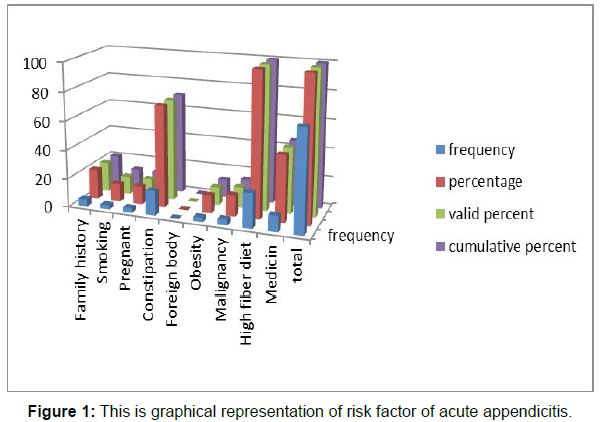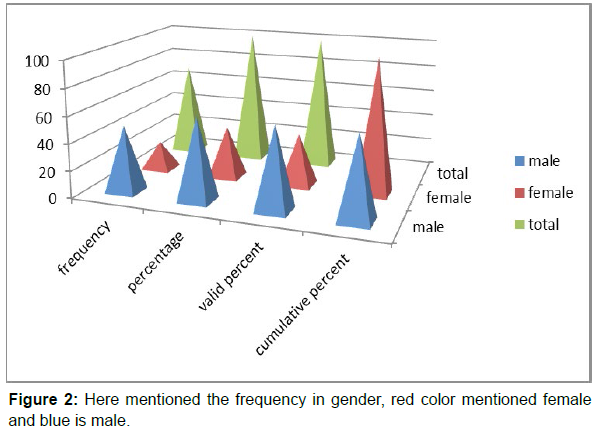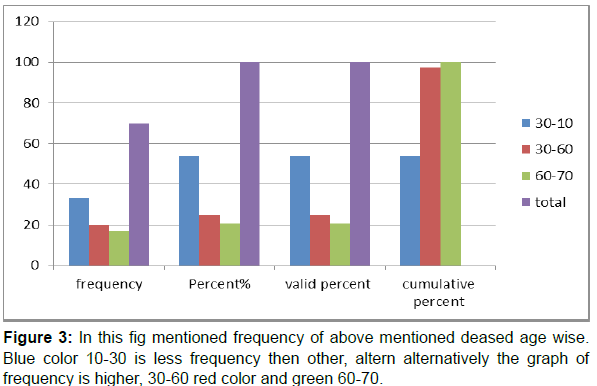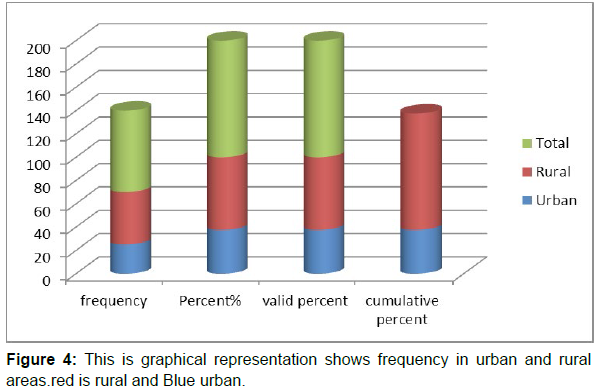Prevalence and Risk Factor of Acute Appendicitis in Patients Present for an Abdominal Ultrasound at Northwest General Hospital (Nwgh) Peshawar
Received: 04-Oct-2022 / Manuscript No. roa-22-76534 / Editor assigned: 06-Oct-2022 / PreQC No. roa-22-76534 (PQ) / Reviewed: 20-Oct-2022 / QC No. roa-22-76534 / Revised: 24-Oct-2022 / Manuscript No. roa-22-76534 (R) / Published Date: 31-Oct-2022
Abstract
Objective: To determine the prevalence and risk factor of acute appendicitis in patients present for an abdominal ultrasound at Northwest General Hospital (NWGH) Peshawar. To compare the gender and age group more risk factor is present and to take frequencies of risk factors.
Methods: This open-label randomized control trial was conducted at Dr. Ruth K.M. Pfau Civil Hospital, Karachi, Pakistan from October 2020 to March 2021. Seventy-five patients were randomized to interventional (n=36, 48%) and control group (n=39, 52%) through sealed envelopes. Diluted solution was prepared by adding 30cc of Ringer’s lactate and 10cc of lignocaine 2%, with 1cc of adrenaline of 1:200000 with 200 ml of normal saline solution. Solution for control group was containing only normal saline. Following the skin harvesting at donor site, a gauze piece soaked with tumescent solution was applied at the donor site wound. Bleeding severity and epithelialization were assessed. Data was recorded in a pre-designed Performa and analyzed through SPSS version-25.
Results: There was no significant differences in baseline characteristics like age (p=0.823), gender (p=0.984) and nature of injury (p=0.936) among two groups. Severe, moderate and mild bleeding was noted in 20/39 (51.3%), 15/39 (38.5%) and 4/39 (10.3%) cases in control group as compared to 0/36 (0%); 2/36 (5.6%) and 25/36 (69.4%) cases in interventional group respectively (**<0.001). No bleeding was noted in 9/36 (25%) cases of interventional group. Complete epithelialization was observed in 24/36 (66.7%) and 17/39 (43.6%) cases in adrenaline and control groups respectively (p=0.045).
Conclusion: Application of adrenaline was more effective in bleeding control and early epithelialization at donor site following the skin harvesting as compared to conventional technique.
Clinical trials registry number: NCT04590638
Keywords
Acute appendicitis; prevalence; Resident; Risk Factor; Peshawar
Introduction
Appendicitis is a state of appendix becomes swollen, puffy and full of secretion. Acute appendicitis (AA) is an acute irritation of the vermiform appendix and tenderness of the vermiform appendix which is most probably due to obstacles to the lumen of the appendix. Causes of impediment include facility, normal stool, infective agent, or lymphoid hyperplasia [1]. The appendix is a worm-shaped blind-ended tube originating from the lowest part of the cecum. The vermiform appendix is an intraperitoneal position (anterior or retrocecal) in contact with the anterior parietal peritoneum. A wide mesentery helps the vermiform appendix rotation in several positions [2]. In 30% of cases, the appendix is located in the pelvis, retrocecal or retroperitoneal [3]. The appendix originated from the posterior medial part of the caecum about 2.5 cm below the ileocecal valve. The appendix may lie in various positions such as preileal, position, parabolic, retrocecal, subcaecal, pelvis, and rarely subhepatic. The appendix is located in the lower’s right part of your abdomen, in an area that refers to as Burney’s point [4]. The standard extent of the vermiform Appendix (VA) is about 9-10 cm (range 2-20 cm). The normal appendix is composed of 5 different layers; the innermost layer which represents the interface of mucosa and the inside lumen, the mucosal layer, the submucosal layer, the muscular propia, and the outermost serosal layer. These layers help to distinguish a normal appendix from an inflamed appendix during a sonographic examination [5]. However, in pregnant females with Acute Appendicitis (AA), the only features shown to be significantly associated with a diagnosis of appendicitis are vomiting, nausea, abdominal pain, and local peritonitis [6]. Complicated appendicitis (Perforation of the Vermiform Appendix or intra-abdominal Abscess) is more common in older patients (>50 Years) more likely due to the greater duration of the symptoms [7]. Regular employ of antibiotics and enhanced hygienic situation lead to reduce occurrence and difference of gastrointestinal microbial flora that may finally lead to a customized reply to viral diseases and thus generate appendicitis, smoke (at hand is also a greater than before occurrence of Acute Appendicitis (AA) in mature patients who smoke every day evaluate to these adults who never smoked). Regular employ of antibiotics and better hygienic circumstances guide to decrease exposure and imbalance of gastrointestinal microbial flora that may finally lead to a customized response to viral disease and thereby acute appendicitis), smoke (readily available is also an enlarge incidence of Acute Appendicitis (AA) in mature patients who smoke every day compared to those adults who never smoked) [8]. The clinical features of Acute Appendicitis comprise hypertrophy of the appendiceal wall, disturbance of the normally covered stricture, obliteration of the walls of the appendix, and purulent fluids or fecaliths within the appendiceal lumen [9]. Acute Appendicitis (AA) is the most occurrence abdominal surgical crisis, In the US it is approximate that around 326,000 operations for appendicitis were achieved in 2008 [10]. In the United Kingdom, around 43000 to 48000 operations for appendicitis were performed yearly between 2007 and 2012 [11]. A big study from the UK and US has revealed that difficult appendicitis is created at the surgery in around 16.5 to 24.4% of cases. The defeat of the submucosal echogenic coating as well as the attendance of hyperechoic periappendiceal fat and a loculated pericycle compilation, are supposed to be symptomatic of puncture [12]. Fatness is immobile a major difficulty for sonography. Since it is complicated to estimate the transducer to the appendix, low-frequency transducers (which have a long focal range but deprived declaration) must be worn, and it is hard to relate enough force to squeeze the bowel sufficiently [2]. Moreover, bags of retrocecal appendicitis can simply be ignored because of the incapability to see from side to side cecum. Particular methods, such as slanted imaging from a creatively placed transducer, may be necessary in such cases. Pelvic (transvaginal) sonography is also helpful in unique appendicitis from gynecological disorders, particularly if the transabdominal movements are questionable [13].
In our study, we have conduct research on acute appendicitis and its risk factor and prevalence because the graph of this problem is recently rise too much in the Peshawar region. According to previous studies, we find out any other topic related to appendicitis like appendicitis in pregnancies, appendicitis in covid-19, etc. therefore we decided to find out the risk factors and prevalence of acute appendicitis by using ultrasonography of the abdominal region.
Literature Review
Conversation Acute appendicitis carries on to be the commonest reason for the surgical abdominal disaster. It was often thought to be the sickness of the young but as a consequence of a fresh increase in life expectations, the incidence of acute appendicitis also improved in the elderly. The incidence of appendiceal perforate in acute appendicitis is estimated to be in the variety of 20-30% which increases to 32-72 % in patients above 60 years of age [14]. The reason at the back this high rate was postulated to be due to the late and out-of-character exterior, delay in ruling and surgical interference, the audience of co-morbid disease, and the age-specific physiological change. To our knowledge, puncture appendicitis was found in 87. Also created in the knowledge was the lack of sex preconception for puncture; 46 (53%) patients were males and 41 (47%) were females. Even though 92 (43%) of all patients had the co-morbid disease at manifestation, the risk of a whole [15]. Our population-based study established that the speed of incidence of acute appendicitis in ESRD patients was higher than in the corresponding. The occurrence rate in the coordinated cohort was somewhat lower than the occurrence. This might be because patients who are under 20 years of age were disqualified as of our assessment while preceding epidemiologic studies have reported that appendicitis is most recurrent among the age of 10 and 20 years. Also, the occurrence rate in male ESRD patients was superior to that in women ESRD patients [16]. Complication, namely postoperative infection is more ordinary in this group of patients. The high amount of hard appendicitis has been assessed in past literature. The pre-hospital delay is also due to the patient’s delay or getting in touch with therapeutic care in the main issue most important to the series from acute to perforated appendicitis [17]. Study on postoperative illness has been carried out in the past with the plan on the way to decrease its incidence and recognize reversible risk factors [18]. Antibiotic prophylaxis is usually given as an amount or a 5-day regimen depending on the ruthlessness of appendicitis. This be shown to be effective in the decrease of postoperative infection in patients undergoing an appendectomy. As compound appendicitis carries significantly extra difficulty than easy acute appendicitis, we aim to recognize risk factors of the postoperative disease and processed the medical result of difficult appendicitis in this research [19].
Method
This study is consisted of 100 samples and is based on a crosssectional study. These all samples are related to the prevalence and risk factors of acute appendicitis for abdominal ultrasound at Northwest General Hospital. This study has been conducted on behalf of the permission of the eminent authority of Northwest General hospital Director. And take ethical approval from all those patients who were related to our study. This study takes time from three to forth months in 2021. The sample size is calculated through Raosoft calculator has been used 95% confidence interval and 5% significant level, and then used a self-administration open-ended questionnaire and analyzed using SPSS version 22 collected 100 samples from North West hospital Peshawar.
Inclusion criteria: Patients of both genders have age 10 to 70 years. Presented with symptoms indicative of acute appendicitis were included in this research Study.
Exclusion criteria: Patients who had a previous appendectomy were excluded from our study.
Data collection procedures
After the approval of the synopsis from the northwest institute of health sciences (NWIHS) Peshawar, formal approval was taken from the radiology department of a northwest general hospital (NWGH) Peshawar. Data were collected by questionnaire and ultrasound reports Data analysis procedures
a) Data analysis was done with SPSS software version 22.
b) Frequencies mean, median, and mode were calculated for categorical variables.
C) Moreover, an inferential statistic was run to find any kind of association between the variables.
Results
This study was done at Northwest General Hospital Peshawar, Radiology Department (NWGH). This study population comprised of outpatients Department (OPD) and also those who were referred by other physicians. The Radiology unit of Northwest General Hospital has four sonologists and four functioning ultrasound machines. A total of 100 patients were included in this study from March to June 2021. They are clinically suspected of clinical appendicitis. U/S was performed by a doctor with experience in GIT ultrasound. In all the collected data, 70% of patients were diagnosed with acute appendicitis, so we observed that males were more in number 49% (61.5%) than females 21% (38.5%) shows that male dominance in acute appendicitis. Moreover, across the survey the age-wise distribution ranged from 10- 70 years, this study has found out that mainly of the suffers were in the age of 10-30 years 33(54.2%) subgroup individually include 30-60 years 20(28.0%) 60-70 years 70 (20.8%). The majority of the patients belonged to Rural Areas 45(62.5%) than Urban Areas 25(37.5%).
The present study has observed the Risk Factors for acute appendicitis, Family history 5(20.8%), Smoking 3 (12.5%), Pregnant females 3(12.5%), Constipation 17(70.8%), Foreign bodies 0(00.0%), Obesity 3(12.5%), Malignancy 4(14.5%), High fiber Diet 24(100.0%), Medicine 11(45.8%). Most of the patients presented with constipation. Finally, we are concluding in this survey the male ratio was dominated quantity than female (Tables 1-4).
| Risk factors for acute appendicitis | ||||
|---|---|---|---|---|
| Risk factor | Frequency | Percentage | Valid Percent |
Cumulative Percent |
| Family History | 5 | 20.8 | 20.8 | 20.8 |
| Smoking | 3 | 12.5 | 12.5 | 12.5 |
| Pregnant | 3 | 12.5 | 12.5 | 12.5 |
| Constipation | 17 | 70.8 | 70.8 | 70.8 |
| Foreign body | 0 | 0.00 | 0.00 | 0.00 |
| Obesity | 3 | 12.5 | 12.5 | 12.5 |
| Malignancy | 4 | 14.5 | 14.5 | 14.5 |
| High fiber diet | 24 | 100.0 | 100.0 | 100.0 |
| Medicine | 11 | 45.8 | 45.8 | 45.8 |
| Total | 70 | 100.0 | 100.0 | 100.0 |
Table 1: This Table shows the frequency percentage of different risk factors for acute appendicitis.
| Gender and their frequency | ||||
|---|---|---|---|---|
| Gender | Frequency | Percentage | Valid% | Cumulative% |
| Male | 49 | 61.5 | 61.5 | 61.5 |
| Female | 21 | 38.5 | 38.5 | 100 |
| Total | 70 | 100 | 100 | |
Table 2: This table shows genders and their frequencies.
| Frequency of Age | ||||
|---|---|---|---|---|
| Age | Frequency | Percentage | Valid% | Cumulative% |
| 10-30 | 33 | 54.2 | 54.2 | 54.2 |
| 30-60 | 20 | 25.0 | 25.0 | 97.2 |
| 60-70 | 17 | 20.8 | 20.8 | 100 |
| Total | 70 | 100 | 100 | |
Table 3: Age of the Patients.
| Resistant of the Patients | ||||
|---|---|---|---|---|
| Resident | Frequency | Percentage | Valid% | Cumulative% |
| Urban | 25 | 37.5 | 37.5 | 37.5 |
| Rural | 45 | 62.5 | 62.5 | 100 |
| Total | 70 | 100.0 | 100.0 | |
Table 4: This table shows people in rural areas were more affected by acute appendicitis.
Discussion
The ultrasound has been observed by a specialist of gastrointestinal tract. Out of a sum of 100 patients, 24 patients were effect with acute appendicitis, and experiential that male was more in numeral 8(61.5%) than female 5 (38.5%) shows that male prevalence in acute appendicitis. Age sharing range from 10-70 years, this study has found out that most of the victim were in the age group of 10-30 years 13(54.2%) subgroups contain 30-60 years 6 (25.0%) 60-70years 5(20.8%). The mainstream of the patients belongs to rustic areas 15(62.5%) than Urban Areas 9 (37.5%). The present study has experiential the risk factors for acute appendicitis, relations history 5(20.8%), smoke 3 (12.5%), Pregnant females 3(12.5%), Constipation 17(70.8%), overseas bodies 0(00.0%), Obesity 3(12.5%), Malignancy 4(14.5%), High fiber Diet 24(100.0%), Medicine 11(45.8%). Most of the patients were obtainable with constipation. According to other research papers on acute appendicitis and its risk factor ratio was mostly slightly differing from our study. We find out that male is more dominant than female because multiple risk factor is involved in the incidence of Acute appendicitis like smoking, diets obesity. Etc. The high fiber diet is also one of the most risk factors for acute appendicitis. Another hand the high fiber diet is a risk factor for many more diseases like obesity, and malignancy however it directly affected or is a risk factor for mentioned disease (acute appendicitis). Another risk factor is medicine, family history, and malignancy it is all interconnected to one another and affected appendicitis. The acute appendicitis ratio in Europe countries is too much low because most cases of appendectomies an early age, therefore, it ratio is low than in the progressive country in our study male has highly affected than female, and rural area is mostly affected than urban area. According to our research, those people who have a high intake of medicine those types of people are more prone to all types of disease but highly prone to acute appendicitis (Figures 1-4).
Conclusion
This critical study concluded of different frequencies in different levels of acute appendicitis and associated risk factors. Most of the patients belonged to rural areas as compared to urban areas. The majority of a patient were in age groups of range from (10-30) years. Male was the dominant subject. A high-fiber diet is the main associated risk factor for acute appendicitis. Other studies on acute appendicitis and its risk factor ratio generally differed only little from ours. Because of many risk factors, including smoking, poor diet, obesity, and other factors, acute appendicitis occurs more frequently in men than in women. One of the biggest risk factors for acute appendicitis is a highfiber diet. On the other hand, a high-fiber diet increases the risk of many more diseases like obesity and cancer. Medicine, family history, and cancer are other risk factors that are all linked to and affect appendicitis. Because appendectomies are typically performed at a young age, the acute appendicitis ratio in European countries is too much lower than in Asian nations. In this study, men were more severely affected than women, and rural areas were more severely affected than metropolitan ones. Our research shows that persons who take a lot of medication are more susceptible to all diseases, but acute appendicitis is particularly common in these individuals.
Recommendation
This study is based on the prevalence and risk factors of acute appendicitis at Northwest General Hospital through ultrasound. Furthermore, we should use different modalities such as 3D computed tomography and increase our sample size for further data collection.
Limitation
The mentioned topic of our research is not broadly defined in the others research paper to collect large information about our topic. The second one, most of the female patients not shared the U/S report with other unconcerned people. Thirdly Due to the Covid-19 pandemic situation was limited to the hospital and the data collection patients.
References
- Benedetto G, Ferrer Puchol MD, Llavata Solaz A (2019) Suspicion of acute appendicitis in adults. The value of ultrasound in our hospital. Radiol. (Engl Ed) 61: 51-59.
- Manatakis DK, Aheimastos V, Antonopoulou ML, Agalianos C, Tsiaoussis J, et al. (2019) Unfinished Business: A Systematic Review of Stump Appendicitis. World J Surg 43: 2756-2761.
- Collard M, Lakkis Z, Loriau J, Mege D, Sabbagh C, et al. (2020) Antibiotics alone as an alternative to appendectomy for uncomplicated acute appendicitis in adults: Changes in treatment modalities related to the COVID-19 health crisis. J Visc Surg 157: S33-S42.
- Mahmood A, Raza SH, Elshaikh E, Mital D, Ahmed MH (2021) Acute appendicitis in people living with HIV: What does the emergency surgeon needs to know?. SAGE Open Med 9.
- Thapa B, Sutanto E, Bhandari R (2021) Thickness of subcutaneous fat is a risk factor for incisional surgical site infection in acute appendicitis surgery: a prospective study. BMC Surg 21: 4-9.
- Lee KW, Ching SM, Ramachandran V, Yee A, Hoo FK, et al. (2018) Prevalence and risk factors of gestational diabetes mellitus in Asia: A systematic review and meta-analysis. BMC Pregnancy Childbirth 18: 1-20.
- Brunner M, Lapins P, Langheinrich M, Baecker J, Krautz C, et al. (2020) Risk factors for appendiceal neoplasm and malignancy among patients with acute appendicitis. Int J Colorectal Dis 35: 157-163.
- Naveen MP, Kamthane S, Reddy A (2021) Importance of clinical, laboratory and imaging parameters in evaluating acute appendicitis. Int J Surg Sci 5: 96-100.
- Giesen LJX, Van Den Boom AL, Van Rossem CC, Den Hoed PT, Wijnhoven BPL (2017) Retrospective Multicenter Study on Risk Factors for Surgical Site Infections after Appendectomy for Acute Appendicitis. Dig Surg 34: 103-107.
- Ananthakrishnan AN (2015) Epidemiology and risk factors for IBD. Nat Rev Gastroenterol Hepatol 12: 205-217.
- Di Saverio S, Podda M, De Simone B, Ceresoli M, Augustin G, et al. (2020) Diagnosis and treatment of acute appendicitis: 2020 update of the WSES Jerusalem guidelines. World J Emerg Surg 15: 27.
- Hämäläinen M (2014) Academic Press Library in Biomedical Applications of Mobile and Wireless Communications: Wireless UWB Body Area Networks. First (edn) Elsevier, UK.
- Bom WJ, Scheijmans JCG, Salminen P, Boermeester MA (2021) Diagnosis of Uncomplicated and Complicated Appendicitis in Adults. Scand J Surg 110: 170-179.
- Quenby S, Gallos ID, Dhillon-Smith RK, Podesek M, Stephenson MD, et al. (2021) Miscarriage matters: the epidemiological, physical, psychological, and economic costs of early pregnancy loss. Lancet 397: 1658-1667.
- Faizi N, Kazmi S (2017) Universal health coverage ‑ There is more to it than meets the eye. J Family Med Prim Care 6: 169-170.
- Kave M, Parooie F, Salarzaei M (2019) Pregnancy and appendicitis: A systematic review and meta-analysis on the clinical use of MRI in diagnosis of appendicitis in pregnant women. World J Emerg Surg 14: 1-14.
- Vogel JP, Vannevel V, Robbers G, Gwako G, Lavin T, et al. (2021) Prevalence of abnormal umbilical arterial flow on Doppler ultrasound in low-risk and unselected pregnant women: a systematic review. Reprod Health 18: 38.
- Karakaş DÖ, Yeşiltaş M, Gökçek B, Eğin S, Hot S (2020) Is language disability a risk factor for complicated appendicitis? A retrospective cohort study. J Surg Med 4: 631-635.
- Polo LR, Montejo JLB, Moncada JPG, Riveros MCO, Córdoba DAL, et al. (2021) Childhood Obesity and Its Relation to the Development of Acute Appendicitis. J Pediatr Neonatal Biol 6: 44-48.
Indexed at, Google Scholar, Crossref
Indexed at, Google Scholar, Crossref
Indexed at, Google Scholar, Crossref
Indexed at, Google Scholar, Crossref
Indexed at, Google Scholar, Crossref
Indexed at, Google Scholar, Crossref
Indexed at, Google Scholar, Crossref
Indexed at, Google Scholar, Crossref
Indexed at, Google Scholar, Crossref
Indexed at, Google Scholar, Crossref
Indexed at, Google Scholar, Crossref
Indexed at, Google Scholar, Crossref
Indexed at, Google Scholar, Crossref
Indexed at, Google Scholar, Crossref
Indexed at, Google Scholar, Crossref
Citation: Rahman N, Umar H, Ishaq Md (2022) Prevalence and Risk Factor of Acute Appendicitis in Patients Present for an Abdominal Ultrasound at Northwest General Hospital (Nwgh) Peshawar. OMICS J Radiol 11: 406.
Copyright: © 2022 Rahman N, et al. This is an open-access article distributed under the terms of the Creative Commons Attribution License, which permits unrestricted use, distribution, and reproduction in any medium, provided the original author and source are credited.
Select your language of interest to view the total content in your interested language
Share This Article
Open Access Journals
Article Usage
- Total views: 3233
- [From(publication date): 0-2022 - Oct 03, 2025]
- Breakdown by view type
- HTML page views: 2707
- PDF downloads: 526




